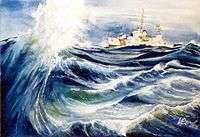USCGC Androscoggin (WHEC-68)
USCGC Androscoggin (WHEC-68) was an Owasco class high endurance cutter built for World War II service with the United States Coast Guard. The war ended before the ship was completed and consequently Androscoggin did not see wartime service until the Vietnam war.
 USCGC Androscoggin (WHEC-68), in the Gulf of Mexico, 13 August 1958 | |
| History | |
|---|---|
| Class and type: | Owasco class cutter |
| Name: | Androscoggin |
| Operator: | United States Coast Guard |
| Builder: | Western Pipe & Steel |
| Launched: | 16 September 1945 |
| Acquired: | 26 September 1946 |
| Commissioned: | 26 September 1946 |
| Decommissioned: | 27 February 1973 |
| Fate: | Sold for scrap, 7 October 1974 |
| General characteristics | |
| Type: | Owasco-class cutter |
| Displacement: |
|
| Length: | |
| Beam: | 43 ft 1 in (13.1 m) |
| Draft: | 17 ft 3 in (5.3 m) (1966) |
| Installed power: | 4,000 shp (3,000 kW) (1945) |
| Propulsion: | 1 x Westinghouse electric motor driven by a turbine, (1945) |
| Speed: | 17 knots (31 km/h; 20 mph). |
| Range: |
|
| Complement: | 10 officers, 3 warrants, 130 enlisted (1966) |
| Sensors and processing systems: |
|
| Armament: |
|
| Notes: | Fuel capacity: 141,755 gal (Oil, 95%). |
Androscoggin was built by Western Pipe & Steel at the company's San Pedro shipyard. Named after Androscoggin Lake, Maine, she was commissioned as a patrol gunboat with ID number WPG-68 on 26 September 1946. Her ID was later changed to WHEC-68 (HEC for "High Endurance Cutter" - the "W" signifies a Coast Guard vessel).[1][2]
Peacetime service
Androscoggin was stationed at Boston, Massachusetts, in 1947 and 1948. She was used primarily on ocean station duty in the North Atlantic. From 1948 to 3 July 1949, she was stationed at New York City.
Decommissioned 1949
She was decommissioned and stored at the Coast Guard Yard, Curtis Bay, Maryland, from 31 October 1949 to 8 May 1950.
Recommissioned 1950
On 8 May 1950, Androscoggin received the crew from cutter Mocoma, was recommissioned, and stationed at Miami Beach, Florida, until 27 February 1973.
Androscoggin was subsequently used primarily for law enforcement and search and rescue operations, but also served several ocean station tours. On 29 and 30 May 1952, she towed a disabled Navy PBM Mariner aircraft from 60 miles southeast of Miami to Miami, Florida. In 1956, she served on Campeche Patrol. In April and May 1956, she was assigned special duty relating to Loran-C testing and visited Ecuador, Jamaica, Colombia, and Panama. In July 1956, she served on the annual reserve cruise to San Juan, Puerto Rico, and Port-au-Prince, Haiti. From 17 April to 4 July 1959, she shared International Ice Patrol duty with the Acushnet. She sailed to Reykjavík, Iceland, in January 1960 on a special mission.
Berlin crisis
In November 1961, she took part in a special mission involving the USAF and the Air National Guard relating to the Berlin crisis.
Training ship
In 1962, the Androscoggin served as Coast Guard schoolship at the Navy’s Fleet Sonar School, Key West.
Cuban refugees and other rescues
In late August 1965, she evacuated Cuban refugees from Cay Sal to Key West. On 10 January 1966, she rescued the crew from the sinking MV Lampsis and unsuccessfully attempted to save the vessel. On 3 February 1966, she stood by the distressed MV Aroin until a commercial tug arrived. On 19 February 1966, she rescued three Cuban refugees from Anguila Cay and transported them to Miami. On 25 May 1966, she embarked 12 Cuban refugees from Cay Lobos and transported them to Key West.
Movie and Television parts
When returning from an Echo patrol, Androscoggin was dispatched to Nassau to take part in the filming of the movie Assault on a Queen, starring Frank Sinatra. In the final segments of the film, Androscoggin, through the miracle of special effects, saves the day by ramming and sinking a renegade submarine, thereby thwarting Sinatra's dastardly plan to rob RMS Queen Mary on the high seas.[3] In the 1968 episode of Get Smart titled "Schwartz's Island" there are stock shots of a USCG Cutter with the designation W68; presumably the Androscoggin.
Vietnam war

Androscoggin was assigned to Coast Guard Squadron Three, South Vietnam, from 4 December 1967 to 4 August 1968. On 1 March 1968, she assisted in the destruction of an enemy steel trawler in a gun battle at the mouth of the Song Cau River. In May 1968, she rescued 27 Vietnamese from the South China Sea.
Return to peacetime duties
In 1969, Androscoggin assisted the Dutch MV Alida Gothern. On 19 February 1970, she stood by the disabled MV Stellanova until a commercial tug arrived. On 29 April 1970, she provided medical assistance to USS Dahlgren off Bermuda.
Decommissioning
She was decommissioned on 27 February 1973, and sold for scrap on 7 October 1974.
Footnotes
- "USCG Androscoggin" (PDF). U.S. Coast Guard History Program. United States Coast Guard. Retrieved 17 December 2012.
- "USCG Designations". U.S. Coast Guard History Program. United States Coast Guard. Retrieved 17 December 2012.
- Information courtesy of Androscoggin crewman John Burmester as recorded at the USCG website.
References
- Androscoggin WHEC-68, United States' Coast Guard website.
- Scheina, Robert L.: U.S. Coast Guard Cutters & Craft of World War II Annapolis: Naval Institute Press, 1981, pp. 1–3.
- Scheina, Robert L.: U.S. Coast Guard Cutters & Craft, 1946-1990 Annapolis: Naval Institute Press, 1990, pp. 18–26.